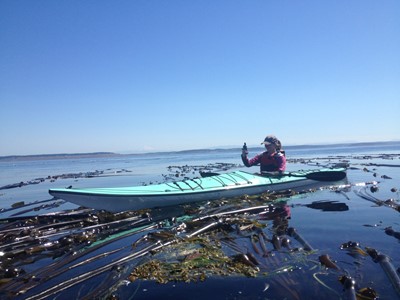Kelp Protection and Recovery
OVERVIEW

The large brown algae commonly known as ‘kelp’ provide habitat to a variety of species in Puget Sound, and are considered critical habitat warranting protection. Kelp, like eelgrass, provides food, shade, and other valuable ecosystem services.
Conspicuous declines in the abundance of bull kelp (Nereocystis luetkeana), the most common canopy-forming species in Puget Sound, have been observed in many areas. The cause is likely a number of factors, including stormwater impacts, sedimentation, and competitive interactions. Little information on abundance, or changes over time, is available in the Northwest Straits region. And much remains unknown about the understory kelp species.
WHAT WE’RE DOING
The Commission launched a regional survey of bull kelp (Nereocystis) beds using a kayak-based survey protocol developed in 2014. Six MRCs recruited volunteers and piloted this project, and the Commission compiled the data and created a regional kelp database. A volunteer pilot photographed project sites in four counties, providing baseline aerial data on the extent of kelp. Click here to watch a short video on the kayak-based survey project.
In December 2015, the Commission convened a workshop to identify changes needed to finalize the protocol for future surveys. The protocol was also added to the PSEMP Nearshore Monitoring Toolbox. As the dataset becomes more robust, it will serve to improve our understanding of kelp abundance in the Northwest Straits region.
Our science advisory committee and partners from natural resource agencies are instrumental in the success of this project.
-
Kelp Project Fact Sheet
Fact sheet about the work of the Northwest Straits Commission on kelp in Puget Sound.
View the Project Details »
-
Mapping bull kelp forest canopies with aerial imagery
A collaborative project between WA State Department of Natural Resources and the Northwest Straits Commission
View the Project Details »
-
Kelp Story Map
A Story Map describing volunteer kayak-based surveys of floating kelp beds in the Northwest Straits Region
View the Project Details »
-
Kelp Survey - Video
A short video from the Northwest Straits Foundation, produced by Transect Films, on the citizen-science kelp survey project.
View the Project Details »